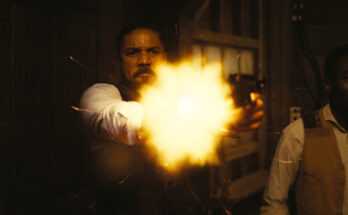Want to hear more from the actors and creators of your favorite shows and films? Subscribe to The Cinema Spot on YouTube for all of our upcoming interviews!
On Monday, June 6th, HBO welcomed us to the world of Irma Vep. Or did they welcome us back?
The show is a new take on the 1996 film of the same name, which is about a contemporaneous film adaptation of the 1916 French silent film, Les Vampires. The story of Irma Vep now spans over 100 years, and its latest installment lands somewhere between the definitions of adaptation, update, and homage. It’s like a nesting doll of mystery, intrigue, drama, and sexy nonsense. For this miniseries, I will be taking you through it episode-by-episode all summer long.
Who is Irma Vep?
In Irma Vep 2022 (IV22), Alicia Vikander plays Mira Harberg, an American Actress who comes to France to star as “Irma Vep” in a new take on Les Vampires. The show-within-a-show is a second attempt to adapt the 1916 silent work by Director René Vidal (Vincent Macaigne), with the first being the film-within-a-film from Irma Vep 1996 (IV1996).
Stay with me, it gets simpler, I promise.
Plot Summary
The show follows Mira, René, and the cast and crew of Irma Vep not only as they clash and collaborate on the show, but also as their personal lives entangle through the constant close contact of a feature film shoot. But who IS Irma Vep?
In Les Vampires, she is one character among many and doesn’t make her debut until the third installment of the silent film series. Irma Vep is a member of The Vampires, the criminal gang for which the films are named, and when we first meet her she is a dancer at a nightclub. Originally portrayed by French silent film star Musidora, Irma Vep is sexy, slinky, scary, and ultimately iconic.
Back in 2022, Mira is stepping into her shoes to try to capture the same magic that rocketed Musidora to stardom in post-WWI France. She is also, to a lesser extent, trying to capture the magic of IV96, but we’ll come back to that later.
One thing IV22 does quite differently from IV96 (which I appreciate), is let us peek into the experiences of other actors working on the show. Not only does this complicate the background drama, it lets us into an exploration of modern set life outside the perspective of a big movie star like Mira. On top of that, it gives us a lot of easy access points to dig deeper into the story of Les Vampires, which helps 1916 feel not so distant as it might otherwise.
Does one need to have seen IV96 to enjoy the current offering? I would vehemently say no. IV22 is certainly in conversation with IVI96, which is fun and fine, but it’s also a totally separate narrative with its own ideas and concerns to explore. We’ll dig into some of the similarities and differences of course, but my biggest recommendation after seeing Episode 1? Watch it on its own terms. Let the story amuse and delight you — I’ll do all the digging into the past for you right here.
So… What happened on this first episode of Irma Vep?
We spend the first half of Episode 1 getting firmly acquainted with Mira’s world. We meet her as she steps off the plane into Paris and follow her through a photoshoot, a premiere with press, and an industry after party. There’s a lot of industry-side quipping and pop culture nods in this section, and although they weren’t always to my taste, I understand the impulse. Where else will you find a perfectly reasonable excuse to poke fun at media giants like Marvel or re-litigate the Ian McKellen/Michael Gambon Mix-Up?
Once she wraps up with her movie work, however, it’s straight to set to join her coworkers and start building the illusive image of Irma Vep. The set life section is no less energetic or slightly frantic, but it does have a more self-serious atmosphere. They often move between modern interiors and older french homes, offices, and natural spaces. The shifts in architecture and lighting definitely do a lot to make the set feel like it’s in its own bubble of time, still moving forward in our world but on its own, more confused, schedule.
IV22 is certainly an ensemble work, and we quickly meet her co-stars, directors, and other crew and members of her team. Most notably, there is Mira’s ex-assistant (and ex-lover) Laurie (Adria Arjona), stylist Zoe (Jeanne Balibar), and the Gen-Z-coded, Deleuze-reading current assistant Regina (Devon Ross). We also dig into castmates Edmond Lagrange (Vincent Lacoste) and Severine (Sigrid Bouaziz) this episode. Best of all: Alex Descas reprises his role as producer Gregory Desormeaux, representing an in-story link to 1996.
The Breakdown
For me, the most exciting part of this episode was the way sexuality was front and center. The question of the day? Power, and the directions in which it flows.
We examine the question of power dynamics in sexual/romantic relationships between two couples: Mira and Laurie, and Edmond and Severigne. Both pairs have had relationships outside their respective jobs that have since ended; both pairs skirt around the question of semi-public displays of sexuality; both pairs end the episode with rejection and disappointment, for Mira and Edmond respectively. But the dynamics at play are totally different.
On the one hand, we have Edmond and Severigne, who discuss a sex scene between their characters that Edmond has been pushing for. Anyone who’s been paying attention to the #MeToo movement would notice the murky waters of this request. Edmond is close with Director René, he is a bigger star than Severigne, and he plays a main character where she plays a side. This could easily turn into a problem.
But after 20 minutes of establishing the issues, a single conversation between the two characters reverses the dynamic completely. Severigne is firm with Edmond and he appears to acquiesce – a pleasant surprise for a pessimist like myself. Suddenly, she has the agency and power to deny this idea, even if on paper she might look susceptible to pressure from above. The table is thus turned, to positive effect!
On the other hand, we have Mira and Laurie, who have the much more distinctly imbalanced situation of a romantic relationship between (ex) employer and (ex) employee. Laurie calls this out early on in her first appearance, and it’s an extremely valid criticism – even if she did deal with it by marrying Mira’s boss, director Herman (Byron Bowers). But the show spends a lot of time showing us that, once again, the power is not necessarily in the hands of who we think it is.
On their first and second interactions, Mira is caught by surprise, and it shows. She is clearly way more into Laurie than Laurie is to her, and this dynamic is exploited to effects that are alternately horny and cringey as hell. Their third interaction shows that Laurie may hold all the power.
Watching Mira squirm on Laurie’s little finger is an utterly new experience for me in terms of LGBTQIA representation, but I’m absolutely thrilled by it nonetheless. I can’t wait for the show to really dive into the dynamics of Mira’s relationships, and treat her sapphic relationships with equal weight to her heterosexual ones. Bisexual girls are winning, but only if they can stomach an icon who relinquishes quite a bit of her pride on a daily basis.
There is much to be made of Mira and Laurie’s relationship, but I think it best expressed with the phrase, “Mira: stand UP!” Tune in with me weekly to find out if she ever does.





8 Comments on “‘Irma Vep’ Season 1 Episode 1 Spoiler Review – “The Severed Head””